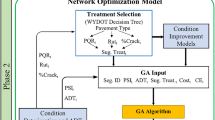Abstract
The simulation of a one-dimensional river network needs to solve the Saint-Venant equations, in which the variable parameters normally have a significant influence on the model accuracy. A Trial-and-Error approach is a most commonly adopted method of parameter calibration, however, this method is time-consuming and requires experience to select the appropriate values of parameter. Consequently, simulated results obtained via this method usually differ between practitioners. This article combines a hydrodynamic model with an intelligent model originated from the Genetic Algorithm (GA) technique, in order to provide an intelligent simulation method that can optimize the parameters automatically. Compared with current approaches, the method presented in this article is simpler, its dependence on field data is lower, and the model accuracy is higher. When the optimized parameters are taken into the hydrodynamic numerical model, a good agreement is attained between the simulated results and the field data.
Similar content being viewed by others
References
NGUYEN Q. K., KAWANO H. Simultaneous solution for flood routing in channel networks[J]. Journal of Hydraulic Engineering, 1995, 121(10): 744–750.
SEN D. J., GARG N. K. Efficient solution technique for dendritic channel networks using FEM[J]. Journal of Hydraulic Engineering, 1998, 124(8): 831–839.
LI Yue-sheng, YANG Shi-xiao and XIAO Zhi-liang. Sparse matrix method for solving implicit scheme system of equations of waterway network unsteady flow[J]. Journal of Zhongshan University (Natural Sciences), 1977, (3): 27–37 (in Chinese).
DRONKERS J. J. Tidal computations of rivers, coastal areas and seas[J]. Journal of Hydraulic Division, ASCE, 1969, 95(1): 29–77.
ZHANG Er-jun, ZHANG Dong-sheng and LI Ting. 3-step method for river net unsteady flows[J]. Journal of East China Institute of Water Conservancy, 1982, (1): 1–13 (in Chinese).
WU Shou-hong. 4-step method for river net unsteady flow[J]. Journal of Hydraulic Engineering, 1985, (8): 42–50 (in Chinese).
LI Yi-tian. A junctions group method for unsteady flow in multiply connected networks[J]. Journal of Hydraulic Engineering, 1997, (3): 49–57 (in Chinese).
LI Y. S., PANG Yong. Hydrodynamic model for river network in Pearl River Delta[J]. Journal of Hydrodynamics, Ser. A, 2001, 16(2): 143–155 (in Chinese).
ZHANG Wei, HUO Guang and ZHU Yu-liang. Prediction model for suspended-sediment transport in unsteady flow in Pearl network[J]. Journal of Hohai University (Natural Sciences), 2005, 33(5): 542–545 (in Chinese).
ZHOU Yi-lin, TANG Hong-wu and LIU Xiao-hua. A split-characteristic finite element model for 1-D unsteady flows[J]. Journal of Hydrodynamics, Ser. B, 2007, 19(1): 54–61.
YANG Fang-li, ZHANG Xiao-feng and TAN Guang-ming. One- and two-dimensional coupled hydro-dynamics model for dam break flow[J]. Journal of Hydrodynamics, Ser. B, 2007, 19(6): 769–775.
FREAD D. L., SMITH G. F. Calibration techniques for 1-D unsteady flow models[J]. Journal of Hydraulic Egineering, ASCE, 1978, 104(7): 1027–1043.
JIN Zhong-qing, HAN Long-xi and ZHANG Jian. The inverse problem of roughness parameter in hydraulic calculation of complicated river net work[J]. Journal of Hydrodynamics, Ser. A, 1998, 13(3): 280–285 (in Chinese).
HAN Long-xi, JIN Zhong-qing. Roughness calibration and formula of area pollution sources basing on three steps method in river network[J]. Journal of Hydraulic Engineering, 1998, (7): 30–34 (in Chinese).
BAO Wei-min, ZHANG Xiao-qin and QU Si-min. Dynamic correction of roughness in the hydrodynamic model[J]. Journal of Hydrodynamics, 2009, 21(2): 255–263.
ATANOV G. A., EVSEEVA E. G. and MESELHE E. A. Estimation of roughness profile in trapezoidal open channel[J]. Journal of Hydraulic Engineering, ASCE, 1999, 125(3): 309–312.
LI Guang-chi, ZHOU Jing-yan and ZHANG Gui-shou. Inverse analysis of river channel roughness parameter by use of Kalman filter[J]. Journal of Hohai University (Natural Sciences), 2003, 31(5): 490–493 (in Chinese).
WU Xiao-ling, WANG Chuan-hai and CHEN Xi et al. Kalman filtering correction in real time forecasting with hydrodynamic model[J]. Journal of Hdrodynamics, 2008, 20(3): 391–397.
DING Y., JIA Y. and WANG S. S. Y. Identification of Manning’s roughness coefficient in shallow water flows[J]. Journal of Hydraulic Engineering, 2004, 130(6): 501–510.
CHENG Wei-ping, LIU Guo-hua. Inverse analysis of channel friction based on generalized inverse theory[J]. Journal of Zhejiang University(Engineering Science), 2005, 39(10): 1063–1068 (in Chinese).
LIU Zhi-xian. Inversion of roughness parameter of river network based on genetic algorithm[D]. Master Thesis, Hangzhou: Zhejiang University, 2008 (in Chinese).
LIN G. F., WANG C. M. A nonlinear rainfall-runoff model embedded with an automated calibration method-Part II: The automated calibration method[J]. Journal of Hydrology, 2007, 341(3–4): 196–206.
LIU S. M., BUTLER D. and BARZIER R. et al. Using genetic algorithms to calibrate a water quality model[J]. Science of the Total Environment, 2007, 374(2): 260–272.
LEI Yan, TANG Hong-wu and ZHOU Yi-lin et al. Application of genetic algorithm for back analysis of roughness parameters in river networks[J]. Journal of Hydrodynamics, Ser. A, 2008, 23(6): 612–617 (in Chinese).
ZHANG X. S., SRINIVASAN R. and BOSCH D. Calibration and uncertainty analysis of the SWAT model using genetic algorithms and Bayesian model averaging[J]. Journal of Hydology, 2009, 374(3–4): 307–317.
MU Jing-bin, ZHANG Xiao-feng. Real time flood forecasting method with 1-D unsteady flow model[J]. Journal of Hydrodynamics, Ser. B, 2007, 19(2): 150–154.
ZHANG Ming-liang, SHEN Yong-ming. Study and application of steady flow and unsteady flow mathematical model for channel networks[J]. Journal of Hydrodynamics, Ser. B, 2007, 19(5): 572–578.
Author information
Authors and Affiliations
Corresponding author
Additional information
Project supported by the National Natural Science Foundation of China (Grant Nos. 50879019, 50879020), the Key Science Project of Guangdong Traffic Department (Grant No. 2008-19).
Biography: TANG Hong-wu (1966-) Male, Ph. D., Professor
Rights and permissions
About this article
Cite this article
Tang, Hw., Xin, Xk., Dai, Wh. et al. Parameter Identification for Modeling River Network Using a Genetic Algorithm. J Hydrodyn 22, 246–253 (2010). https://doi.org/10.1016/S1001-6058(09)60051-2
Received:
Revised:
Published:
Issue Date:
DOI: https://doi.org/10.1016/S1001-6058(09)60051-2




